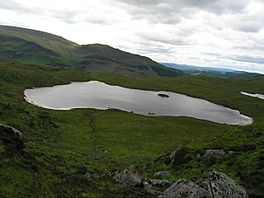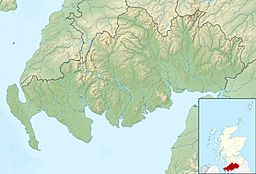Round Loch of Glenhead facts for kids
Quick facts for kids Round Loch of Glenhead |
|
|---|---|

The loch in summer 2006 looking approximately southwest from the slopes of Craiglee towards Mulldonach (centre) and Lamachan Hill (left).
|
|
| Location | Galloway, Scotland |
| Coordinates | 55°5′36.7″N 4°25′48.78″W / 55.093528°N 4.4302167°W |
| Type | natural |
| Primary inflows | blanket peats (seepage & pipeflow) and minor streams |
| Primary outflows | Round Loch Burn |
| Catchment area | 0.90–0.95 km2 (0.35–0.37 sq mi) |
| Surface area | 12.7 ha (31 acres) |
| Max. depth | 13.5 m (44 ft) |
| Residence time | 90 days |
| Surface elevation | 295–298 m (968–978 ft) |
The Round Loch of Glenhead is a beautiful, small lake located high up in the hills of Dumfries and Galloway, Scotland. It's found inside the amazing Galloway Forest Park, just west of a hill called Craiglee. This loch is like a twin to the nearby Long Loch of Glenhead. Both lakes are similar in size and each has a small island. The Round Loch of Glenhead is an important natural spot, known for its unique environment.
Contents
About the Loch and Its Surroundings
The Round Loch of Glenhead is a type of lake called an "upland single basin loch." This means it's a lake high in the mountains that has one main deep area. It's located in the Galloway Forest Park, a huge area of forests and hills. The loch sits next to the Long Loch of Glenhead. Both lochs are separated from Loch Valley and Loch Naroch by an area called the Rig of the Jarkness.
The water from the Round Loch flows out to the southwest through a stream called Round Loch Burn. This stream then joins into Glenhead Burn, which eventually flows into Loch Trool.
The Land Around the Loch
The area of land that collects water for the loch is called its catchment. This catchment covers about 90 hectares (which is like 90 football fields) on the slopes of Craiglee and some flatter areas near the loch. This area gets a lot of rain, about 2.3 meters (over 7 feet) every year!
The ground here has different types of soil. Some areas have thick peat, which is made of decayed plants. Other spots have bare granite and tonalite rocks. The land is not covered by forests and has plants typical of moorland and blanket mires. These are wet, peaty areas. Cows graze here only in the summer. In the past, sheep also grazed, and sometimes the peat was burned.
Protecting the Environment
The Round Loch of Glenhead and its surrounding land are part of special protected areas. These include the Merrick Kells Site of Special Scientific Interest (SSSI) and a Special Area of Conservation (SAC). These titles mean the area is very important for its plants, animals, and natural features. It's also part of the Silver Flowe-Merrick Kells UNESCO biosphere reserve. This means it's recognized globally for its special natural and cultural value.
Monitoring the Loch's Health
Since 2005, scientists have been watching the loch closely. Groups like the United Kingdom Lake Ecological Observatory Network and the Upland Waters Monitoring Network (which used to be called the United Kingdom Acid Waters Monitoring Network) check the water quality. As of 2011, the Round Loch of Glenhead was known as the best-equipped place in the UK to monitor the health of upland waters and the creatures living in them.
The loch is described as oligotrophic and polymictic. "Oligotrophic" means it has low levels of nutrients, so the water is usually very clear. "Polymictic" means its water layers mix together many times throughout the year.
Dealing with Acidification
The loch has had problems with acidification. This means the water became too acidic, which can harm plants and animals. As of 2012, the loch had started to get better, but it was still affected. Levels of nitrate and sulphate, which can make water acidic, were also high.
From July 2013 to December 2014, the pH of the water, which tells us how acidic or basic it is, changed from 4.1 (quite acidic) to 6 (less acidic). The amount of dissolved oxygen in the water, which fish and other creatures need to breathe, ranged from 8.7 to 12.7 milligrams per liter.
Plants Around the Loch
The main plants you can find in the area around the loch include:
- Moor grass
- Heathers, including common heather
- Bracken
- Sedge
You can also find other plants that commonly grow in wet, peaty moorland areas, such as moor matgrass and potentilla.


